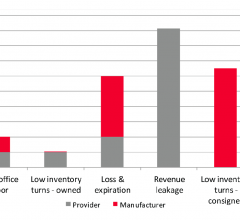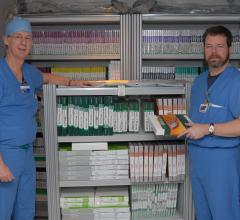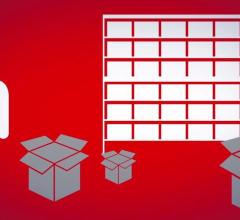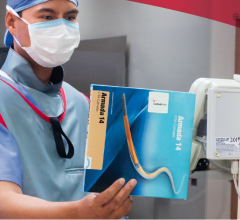
Many CVIS-based inventory control systems use barcode readers to automatically track inventory, as shown here with McKesson's cardiology inventory control system.
Computerized and semi-automated inventory control system technology offers a more efficient way for cardiovascular departments, especially catheterization and electrophysiology (EP) labs, to track what is on their shelves, when to re-order supplies, their actual costs per procedure and to identify new ways to cut costs.
There are three ways inventory control systems can track items — barcode scanning, radiofrequency identification (RFID) tags and drop-down box selections. Barcode systems require all tracked inventory to be labeled with a sticker bearing a barcode that corresponds with cataloged items in the inventory control system. The items are then scanned with a laser barcode reader, allowing quick, automated data entry into a system. RFID systems utilize stick tags similar to anti-theft RFID security tags that set off alarms at stores. All items are tagged and then stocked into a RFID cabinet, which automatically reads the tags as they enter or leave the cabinet. This enables an accurate count of what is on hand, what was removed, when and by whom.
“Inventory systems will cost money on the front end, but you will save money on the back end,” said Marcia Deeb, CVIS coordinator, Washington Hospital, Washington, Penn. “We really know what is on our shelves, and we only have our re-orders set based in minimum and maximum numbers of what is on hand. We can now see what we are actually using and what it really costs to do a right cath compared to a peripheral cath.”
Over the past year, Washington Hospital has implemented McKesson Cardiology Inventory to track items in the cath lab. It is now phasing it in for the cardiac care unit (CCU). Deeb said the barcode-based system has fit well into the nurses’ workflow, scanning the item as it is used. Previously, nurses used a paper and sticker system to record what they used, but everything had to be manually entered and tracked. She said many times they just eyeballed items on the shelves to decide if they needed to order more items. The new system automatically tracks everything and sends a report to the inventory clerk to reorder supplies that are running low. The system also allows queries to compare costs and supplies used for various procedures.
The McKesson system is tied into billing, which charges patients as items are scanned. Users can also set up one-click order sets, so numerous items can be bundled for a procedure.
Florida Hospital, Adventist Health System, adopted the Lumedx Apollo Advance Inventory Module in 2001 to better manage its stocks of cath and electrophysiology (EP) lab supplies. It is a barcode-based system that allows all supplies to be scanned as they are used or pulled for a procedure. It also uses drop-down boxes to for common disposables. “It has worked very, very well. Lumedx has really stepped up to the plate and it most certainly has allowed us to be more efficient,” said Barry Egolf, RN, nurse manager, invasive cardiovascular services.
In addition, four years ago the hospital installed Wavemark RFID cabinets for high-ticket cath and EP lab supplies, such as stents, balloons and implantable devices. Since implementation of both inventory tracking systems, Egolf said Florida Hospital has saved millions by better tracking expiration dates, usage, theft prevention, billing capture and knowing exactly what is used for better contract negotiations with vendors.
Florida Hospital has 17 cath labs using the system, including six cardiac, five EP, two interventional radiology, two interventional neurology, one vascular lab and a pediatric hybrid OR. The primary use of these systems is in the cath labs, where real-time inventory tracking data offers a clear picture of the types and volume of procedures being done and what supplies they require. He said this enables the hospital to reliably predict what supplies are needed on hand at all times and at what level supplies should be reordered. Egolf said this helps Florida Hospital maintain a much leaner inventory.
“Most vendors sell on consignment, so it is free until you use an item, but it does not mean we have the real estate to store everything,” Egolf said.
WakeMed Health and Hospitals in Raleigh, N.C., uses GE Healthcare’s Centricity Cardiology with the barcode-based DMS inventory control system in their cath and EP labs. The system currently manages about 3,500 items in this inventory.
The system categorizes inventory into two types — perpetual or periodical. Items that are perpetual will automatically get ordered when the number on hand gets below a certain number and periodicals are ordered by shelf utilization. Wake Med also interfaced its inventory system with Lawson (a hospital-wide materials management system), so all ordering, purchase order generations and receiving are performed in Lawson.
Cutting Costs
The main cost savings from inventory systems are found in streamlining the number of items in stock. At Washington Hospital, the McKesson system helped identify the use of 12 different types of wires in stock, ordered by several physicians, which was reduced down to just three types of wires.
The tracking systems can help with loss prevention, making it much easier to track when items go missing, such as theft of high-ticket items, both Deeb and Egolf said.
Since inventory tracking systems offer a clear picture of what a cath lab uses, a hospital knows exactly what it needs and this can greatly help when negotiating volume discounts. “Understanding what volume you are using is really important when negotiating contracts with vendors,” Egolf said.
“It helps with contract negotiations,” Deeb continued. “If a vendor asks you to use their product in 70 percent of your cases, you can see your actual usage of the products. This makes contract negotiations easier.”
Several companies also offer no-cross guarantees, so if their balloon does not cross a lesion, but another brand does, the vendor will replace their product at no charge. Because of this system, Egolf has been able to achieve savings of tens of thousands of dollars per month in wasted devices. The Lumedx system also adds a layer of data integrity for vendors because it ties the inventory items to how they were clinically utilized.
Another way these systems help cut costs is through better tracking of expiration dates. Manual tracking of various expiration dates on a large number of items can be very complex and tedious, but Egolf said automated systems greatly simplify this process and can help avoid disposing of unused expired stock.
Tracking Costs
Inventory tracking can help better manage the bottom line by breaking down costs to see what the actual cost is by procedure, by disease state and even by physician.
“The one thing we really, really like is the statistical data we can get back out of the system,” Deeb said. “If I want to know the cost per case, or how to create a set of items, or what vendors we are working with, I can find all that in the system.”
In the current era of cutting costs due to lower reimbursements, inventory systems can help show physician efficiency. In most cases, Egolf said physicians are very good at keeping costs down and not using unnecessary supplies.
“That has pretty much been an eye-opener when we used the system’s analytics,” he explained. “This gives the physicians the opportunity to have their practice defended,” he said. “Today everything is about best practices and this affords physicians the justification for what they are doing.”
Hospitals looking to purchase one of these systems should ensure it can easily be used to data mine.
“You have got to be able to mine the data from the inventory tracking system information or else you are not taking full advantage of the technology,” Egolf said. It also needs to be easy to query the system for specific items, doctors, types of procedures, etc. If a system requires IT to get involved to find the information, he said it makes the system more difficult to use and less likely inquires will be made.
WakeMed configured its administrative reports to run automatically for different time frames (daily, weekly, monthly, periodically and annually) to provide insights on their stock level, utilization and costs. Among the reports they created are daily usage, shelf counts, utilization by physician and cost per case.
IT Considerations
He said one of key things to keep in mind when reviewing systems for purchase is their ease of use. Not only should it be easy to access, use and query information, but also it is essential for new products to easily be added. In the case of barcoded items, most hospitals use their own specific identification numbers, which need to be combined with vendors’ barcodes so it can be scanned in properly. The more difficult this is to do, the less user-friendly the system, Egolf said.
“As an administrator, you need the system to be malleable to meet the needs of your unique hospital,” Egolf explained.
Another requirement is easy interfaces via HL7 with other key systems, such as admission, discharge and transfer (ADT), hospital information systems (HIS) and the cardiac PACS.


 April 28, 2017
April 28, 2017 








